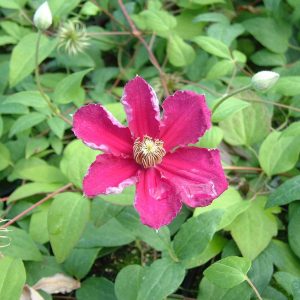Description
Viburnum plicatum is a deciduous shrub that is known for its layered, horizontal branching pattern and beautiful, lacecap-like clusters of white flowers that bloom in late spring. The leaves are a fresh green and turn a purplish-red in the autumn. The shrub grows to a height and spread of around 3 meters and prefers full sun to partial shade and well-drained soil. It is a popular choice for hedging, as a specimen plant or as a backdrop for other plants in a mixed border. Viburnum plicatum is also attractive to bees and other pollinators, making it a great addition to any wildlife garden.
Key Facts
- Common Name(s):Japanese Snowball ‘Kilimanjaro Sunrise’
- Hardiness:Fully hardy through most of the UK
- How big will I get? Viburnum plicatum ‘Kilimanjaro Sunrise’ can grow to a height of 3m and a spread of 3m.
- Did You Know That:Viburnum can have up to 4 periods of colour through the year, with up to two flushes of flowers, berries and often fiery foliage in Autumn?
Plant Calendar
A rough guide to how this plant will change through the year.
| Jan | Feb | Mar | Apr | May | June | July | Aug | Sept | Oct | Nov | Dec | |
| Flowering Time |  |
 |
||||||||||
| Foliage Colour |  |
 |
 |
 |
 |
 |
  |
  |
  |
| J | F | M | A | M | J | J | A | S | O | N | D |
 |
 |
||||||||||
 |
 |
 |
 |
 |
 |
  |
  |
  |
Care Guide

Soil Requirements
Viburnum plicatum ‘Kilimanjaro Sunrise’ is a versatile plant and can cope with wet or drier soils, but prefers there to be decent drainage. This plant can grow in soil with a wide range of pH levels, it is not picky about the pH level of the soil.

Best Position
Viburnum plicatum ‘Kilimanjaro Sunrise’ can handle either an exposed or a sheltered position and can cope with either full sun or partial shade.

Maintenance
Viburnum plicatum ‘Kilimanjaro Sunrise’ can be pruned immediately after flowering, which consists of lightly trimming the plant to help maintain a pleasant shape to the plant. If you want the plant to produce berries then any shaping should be done carefully, remembering to leave at least a percentage of spent flowers intact.

Pest, Diseases and Wildlife
Viburnum plicatum ‘Kilimanjaro Sunrise’ can have problems with aphids, it can be vulnerable to certain diseases such as leaf spot. It is considered to be toxic.





